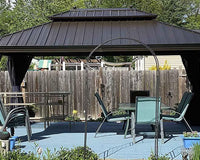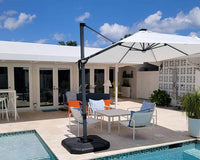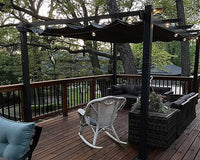QA
No, some outdoor pergolas do not have to be anchored in the same way others do. Permanent pergolas, however, need strong anchoring that will keep them in place for years. Those made for temporary use are usually lighter and can therefore rely on methods such as ground screws, weighted planters or sandbags. This is determined by various factors, including the size of the pergola, weight, intended permanence, and local building codes.
Introduction
A well-designed pergola enhances both appearance and functionality. However, the response to whether all pergolas should be anchored depends on these key determinants. This article will outline the differences between permanent and temporary pergolas, discuss how you should take into account size and weight as you anchor them, and look at local building codes that might affect your choices. Whether you're putting up a tough structure for several seasons or one that will barely last a summer in your garden, learn how to secure it properly to avoid any accidents.

How to Judge If Your Pergola Requires Anchoring?
Before you begin setting up your beautiful new backyard pergola, it's vital to determine if it needs to be anchored down. Anchoring can ensure that your pergola stands firm against the elements and remains a safe structure in your outdoor living space.
Permanent vs. Temporary Structures
One must first decide if their structure is meant to be permanent or temporary before considering other aspects of a new living space like type of vegetation and location among others. Permanent Pergolas are generally long term features in your backyard or garden so they demand robust anchoring systems which involve digging post holes then setting posts with concrete footings to ensure they survive wind, weather changes over time.
On the other hand, though, if you're going for a temporary one like those used during an event or seasonally, there's no need to go overboard with anchoring it. Such structures often use lighter forms of anchorage hence enabling easy installation processes or removal. Ground anchors that screw into the soil are common light anchoring devices used for these types of structures, but on other occasions, people may employ large pots filled with heavy soil or rocks instead of this kind of anchorage material.
Size Matters
In general, bigger pergolas catch more wind and carry more weight, thus needing stronger anchoring options to hold them in place safely. On the other hand, smaller and lighter pergolas have less surface area and mass, so they must be anchored to keep them from toppling over or blowing away.
Complying with Local Codes
Local building regulations are there to keep you safe, and adhering to them is non-negotiable. Depending on where you live, your local building codes may dictate that all outdoor structures, including pergolas, need to be securely anchored, regardless of size. In other jurisdictions, requirements may vary based on the pergola's size or design. It's essential to check with your local building authority before proceeding to ensure your pergola project complies with all necessary regulations.

How to Anchore Pergola?
Setting Up with Concrete Footings
For permanent pergolas, concrete footings are the gold standard of anchoring. These involve digging holes to a depth below the frost line in colder climates and filling them with concrete. Here's how it typically works:
- Marking the Spots: Start by carefully marking where each post of the pergola will go.
- Digging Holes: Dig holes at these spots, ensuring they are wide and deep enough to hold the posts securely.
- Preparing Concrete: Mix the concrete according to the manufacturer's instructions - it should have a consistency similar to peanut butter.
- Pouring Concrete: Pour the concrete into the holes around the pergola posts. You can either set the posts directly into the concrete or insert metal post anchors into the concrete and attach the posts to them after the concrete has cured.
- Securing Posts: Ensure the posts are level and plumb as the concrete sets. It usually takes at least 24-48 hours for the concrete to cure enough to support the pergola's weight.
This method provides a reliable and durable anchor that can resist uplift forces from wind and the weight of snow or climbing plants that may adorn your pergola over time.
Lighter Anchoring Alternatives
If your patio pergola is temporary or if local codes permit, there are alternative anchoring methods that are less labor-intensive than concrete footings:
- Ground Anchors: These are long screws that drill into the ground and provide a decent amount of stability without needing excavation.
- Weighted Planters: Placing heavy planters at the base of the pergola posts not only secures the structure but also adds to its aesthetic appeal.
- Concrete Blocks: Concrete blocks can be used as a semi-permanent anchoring solution, often employed when the pergola needs to be moved occasionally.
- Sandbags: For event pergolas or very light structures, sandbags can offer enough weight to prevent the pergola from shifting or tipping.
Assessing Pergola Size and Weight for Proper Anchoring
In ensuring that you anchor it properly, both the size and weight of an outdoor structure are very important.
Pergola Size
Larger pergolas with wide roofs and longer beams inherently catch more wind, just like sails. If not anchored properly, stronger winds can uproot these larger ones during severe weather conditions. To prevent this from happening, large pergolas should have a firm base:
- Broad Footings: Having broad footings offers greater stability. Widening your concrete foundation at the bottom can help distribute weight better and offer good support for big pergolas.
- Deeper Support: For regions with freezing ground temperatures, the footings should extend below the frost line to prevent heaving and shifting as the ground thaws and freezes.

Pergola Weight
The material used in making your garden pergolas, such as wood, metal, or vinyl, will determine how heavy it is hence affecting the anchoring method:
- Heavy Wooden Pergolas: Wood is substantial, and a timber pergola can often stand against the wind due to its own weight. However, this doesn't eliminate the need for anchoring; it simply means that your anchoring can leverage the pergola's mass.
- Light Metal or Vinyl Pergolas: Aluminum and vinyl are lightweight options that typically require secure anchoring. Since these materials offer less natural resistance to uplift, the anchoring system must compensate to keep the pergola grounded.
Balancing Stability and Location
Apart from size and material type, location affects how you anchor a pavilion:
- Wind Exposure: If your pergola is in an open area with high wind exposure, you will need stronger anchoring compared to a sheltering environment.
- Soil Type: Loose or sandy soil may require deeper anchors or larger concrete footings for adequate hold, whereas clay-heavy soils can provide more natural stability.
Build a Secure Pergola that is Well-anchored
Though not all pergolas require anchoring, most will benefit from it to ensure stability and safety. Regardless of whether your pergola is a permanent structure weathering the elements throughout the year or a temporary setup for special events, appropriate anchoring according to its size, weight, and local building regulations becomes necessary. In such cases, long-lasting structures demand more aggressive means of securing them, like concrete footings, as opposed to temporal ones, which may use lighter options such as ground anchors or planters filled with soil. A well-secured gazebo should be an extension of your living space that securely blends beauty and peace of mind.




